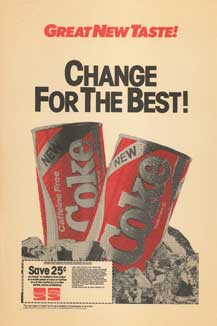
Change before you have to. – Jack Welch
How well do you embrace change? Is it in your nature to be an early adapter to change or are you one of the last to get on the change wagon?
It’s been said that the only constant in life is change. And while that much is true, some find it more difficult to embrace than others. To be sure, not all change is bad, and not every change is worth embracing. Somewhere in between is the tension that is real for many.
One of the most infamous changes in business history occurred back in 1985. Pundits referred to it as the “marketing blunder of the century”, and the backlash was more like a customer rebellion.
The formula for Coke had not been tampered with for 99-years. But in 1985, they changed it, and “new Coke” was released. Coke customers were not impressed. The new formula was a bust. Customers stock-piled the original Coke in their basements, the customer service hotline which normally received 400 calls a day was now receiving more than 1,500. The message Coke customers delivered was simple – the old formula has worked for

Credit: Google Images
99 years, why change it?
It took just 79 days for Coke to reverse their “marketing blunder” and revert to their original formula. It was a painful lesson at the time for Coke, and one from which every leader today can learn from.
Leading at the speed of change can be challenging. How you manage it, lead it, and how you compel others to change is important. But first and foremost, it’s an inside job. If you are not willing to change, then you may be the obstacle to progress your organization needs.
In this two-part series, I will explore six obstacles to change that hold leaders back. In this post, let’s take a look at the first three.
Comfort zones
One of the chief reasons why we resist change as individuals and in our organizational structures is that we get settled in comfort zones. It’s an autopilot mindset that we are way too comfortable with. It’s the proverbial ‘new Coke’ formula mindset – it’s been the same and has worked for 99-years, why change it?
In our comfort zones, we tend to protect the status quo and become guardians of the past. If you are a leader stuck in your comfort zone you are a leader who needs to embrace change.
Habits
Most of us are creatures of habit. And just like our comfort zones, we tend to stick close to the familiar. At times, embracing change may require relinquishing old habits for the sake of growth. But old habits can be blindspots. So long as you don’t see how your habits stand in the way of progress we will never be compelled to change.
Your leadership in many ways is an extension of the habits you’ve developed over time. Ask yourself if those habits that served you well in years gone by are still useful today? What habits need to change for the sake of change?
Attitude
Oftentimes, it’s not change itself that’s problematic, it’s our attitude towards change that’s the issue. The reason in part, I believe, is that we go straight to negative thoughts about change. We think it’s going to be something bad. We fear the unknown so we hunker down determined to preserve the way things are. We like the formula just the way it is.
If you want to be a change agent within your organization, you have to model the attitude you hope to see in others. Change is challenging enough as it is without your negative attitude to deal with.
Final Thoughts
In Part 2, I will close out How Change Impacts Your Leadership. Until then, I challenge you to look at areas of your leadership where you tend to resist change and how different things would look if you didn’t.
©2021 Doug Dickerson
